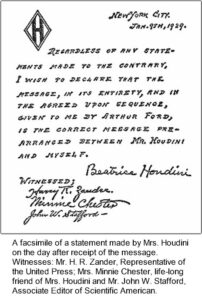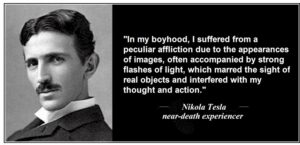This site uses affiliate links to Amazon.com Books for which IANDS can earn an affiliate commission if you click on those links and make purchases through them.
1. Introduction to Nikola Tesla and Harry Houdini
Nikola Tesla and Harry Houdini, two towering figures of the late 19th and early 20th centuries, left indelible marks on the worlds of science and entertainment, respectively. While Tesla is celebrated for his pioneering work in electrical engineering and inventing technologies that shape our modern world, Houdini is remembered as the master escape artist and illusionist whose performances thrilled audiences globally. Beyond their public personas, both men had profound personal experiences that touched on the mysterious phenomenon of near-death experiences (NDEs).
Tesla, whose inventive genius often bordered on the mystical, had episodes where his intense focus and work led him to states that closely mirrored the elements described in NDEs. His accounts of visionary insights and encounters with otherworldly phenomena blur the lines between scientific inquiry and spiritual experience. Houdini, on the other hand, despite his deep skepticism and relentless debunking of spiritualist frauds, was not immune to the allure of the afterlife. His lifelong quest to understand and, if possible, contact the beyond led him to an NDE that profoundly influenced his views on life, death, and the possibility of an afterlife. These NDEs of Tesla and Houdini offer fascinating glimpses into the minds of two extraordinary men, highlighting their unique intersections with the unknown and their enduring legacies in both their respective fields and the broader quest to understand the mysteries of human existence. Many people have given remarkably similar near-death testimonies. Here are two similar NDEs by two of the most brilliant people in the 20th century: Nikola Tesla and Harry Houdini.
2. Nikola Tesla and His Near-Death Experience
a. About Nikola Tesla and His Inventions
Nikola Tesla (1856–1943) was a Serbian-American inventor, electrical engineer, mechanical engineer, and futurist. Tesla was a scientific giant. But he also had uncontrollable psychic visions. He had a vivid premonition of his mother’s death at the moment she died. He also experienced several visions that saved his own life. Plagued by illness as a boy, Tesla spent much of his youth reading and imagining inventions. Tesla wrote:
“In my boyhood I suffered from a peculiar affliction due to the appearance of images, often accompanied by strong flashes of light, which marred the sight of real objects and interfered with my thoughts and action. They were pictures of things and scenes which I had really seen, never of those I imagined. When a word was spoken to me, the image of the object it designated would present itself vividly to my vision and sometimes I was quite unable to distinguish whether what I saw was tangible or not.”
This “affliction” seems to have served him well in later years: he despised freehand drawing and was able to conjure complete blueprints and specifications for his inventions in his head.
For a video and more info on Tesla visit: www.pbs.org/tesla/
Tesla was a brilliant student who demonstrated an early knack for inventing. After reading the works of physicist and spiritualist Sir William Crookes, he decided upon a career in electronics.
Tesla is known for his contributions to the design of the modern alternating current (AC) electricity supply system among many other inventions. Tesla was one of the most gifted scientists the world has ever known. Tesla was a pioneering inventor whose work in the late 19th and early 20th centuries significantly advanced electrical engineering and technology. Here are some of his most notable inventions.
Alternating Current (AC) System: (1) Tesla developed the polyphase AC system, enabling efficient long-distance electrical power transmission. (2) His invention of the AC induction motor revolutionized the use of electricity in industry and households.
The Tesla Coil: (3) The “Tesla coil” produces high-voltage, high-frequency electricity, and is used in radio technology and demonstrations.
Wireless Technology: (4) Tesla made key contributions to the development of radio technology. (5) The Wardenclyffe Tower was an ambitious project for global wireless communication and power transmission, though never completed. Other inventions include (6) A bladeless turbine (Tesla Turbine) designed for high efficiency in power generation. (7) Early developments in neon and fluorescent light technology. (8) Tesla invented the first remote control, demonstrating a radio-controlled boat in 1898.
Other contributions to other fields include: (9) Tesla conducted experiments with X-rays, contributing to early developments in the field. (10) Tesla developed methods in cryogenics for cooling and liquefying gases. Tesla’s work laid the foundation for many modern technologies and continues to influence contemporary science and engineering.
b. Nikola Tesla’s Near-Death Experience
In his autobiography, My Inventions, Tesla describes that, at age 14, he was swimming in the river near his hometown in Croatia. To impress his friends he dove and swam underwater to a diving dock some distance away from the shore, intending to swim under it and emerge where his friends couldn’t see him. He swam until he was sure he was clear of the dock and came to the surface. He banged his head on a beam under the dock. He swam farther and came up again, and hit his head once more. Now out of breath, he had a vision of the entire floating dock and realized that he could come up to a point between the slats and breathe that way.
Luckily for him, the strategy worked. It still took him many attempts before he reached open water.
Tesla wrote: “At that moment when my situation seemed absolutely hopeless, I experienced one of those flashes of light and the structure above me appeared before my vision. I either discerned or guessed that there was a little space between the surface of the water and the boards resting on the beams and, with consciousness nearly gone, I floated up, pressed my mouth close to the planks and managed to inhale a little air.”
Fortified with oxygen, Tesla was able to find his way out as his friends were fishing for his body.
3. Harry Houdini and His Near-Death Experience
a. About Harry Houdini
Harry Houdini, born Erik Weisz (1874–1926), in Budapest, Hungary, and later known as Ehrich Weiss, is one of the most legendary figures in the history of magic and escapology. Immigrating to the United States with his family at a young age, Houdini’s life story is a classic tale of an immigrant rising to extraordinary fame and success through talent, determination, and relentless self-promotion. Known for his sensational escape acts and masterful illusions, Houdini captivated audiences around the world with feats that defied explanation and seemed to challenge the very limits of human capability. His extraordinary life, marked by both dazzling performances and a fierce quest for truth, has left an indelible mark on the world of entertainment and continues to inspire magicians and illusionists to this day.
b. Harry Houdini’s Near-Death Experience
A similar event with Nikola Tesla occurred in the life of Harry Houdini who did one of his escapes from a strait-jacket after being lowered, in chains, through a hole bored in the frozen Detroit River. He easily escaped the strait-jacket and the chains and was paddling toward the surface toward the hole. To his horror, the hole wasn’t above him. The current had carried him down the river and he had no idea where the escape hole was located. His chest was heaving for lack of air and he had resigned himself that he would drown. Instead, he saw a brilliant light over his head and swam for it. He found his head above water, but not at the hole. He had climbed into a natural air pocket. Able to breathe, he fought the current to return to where he found the chain and strait jacket.
c. Houdini’s Secret Afterlife Password Revealed by Arthur Ford
Beyond his spectacular stage performances, Houdini harbored a deep fascination with the paranormal, dedicating a significant portion of his life to debunking fraudulent mediums and spiritualists who preyed on the grieving. Despite his skepticism, Houdini made a pact with his wife, Bess, to test the possibility of life after death: he would attempt to communicate a secret code to her from the other side, if such a thing were possible. This promise led to one of the most intriguing episodes in the world of spiritualism, involving a medium named Arthur Ford.
Before his untimely death on October 31, 1926, Houdini shared a secret code with Bess, derived from their old vaudeville mind-reading act. This code was intended to serve as proof of his ability to communicate from beyond the grave, should he succeed. The code, which consisted of a series of ten words corresponding to letters in the alphabet, was known only to Houdini and Bess.
Arthur Ford, a prominent medium and spiritualist of the time, entered the scene claiming to have received communication from Houdini. Ford, known for his involvement with the Spiritualist Church and his work as a medium, had garnered a reputation for his ability to contact the deceased.
In January 1929, Ford announced that he had received a message from Houdini through his spirit guide, Fletcher. During a séance held on January 8, 1929, in New York City, Ford purportedly conveyed Houdini’s secret message to Bess.
According to Ford, the message was the prearranged code: “Rosabelle believe,” which Bess confirmed as the correct phrase. This phrase was a poignant reference to the song “Rosabelle,” which had sentimental value to the couple, combined with the word “believe,” underscoring the significance of faith in the communication.
Bess Houdini publicly acknowledged the success of the séance, stating that Ford had indeed communicated the secret message from her late husband. She signed a written statement declaring, “Regardless of any statements made to the contrary, I wish to declare that the message in its entirety and in the agreed-upon sequence given to me by Arthur Ford is the correct message prearranged between Mr. Houdini and myself.”

4. Arthur Ford and His Near-Death Experience
a. About Arthur Ford
Arthur Ford (1896–1971), a renowned American medium and spiritualist, is perhaps best known for his controversial claim of communicating Harry Houdini’s secret message from beyond the grave. However, beyond his publicized encounters with the spirit world, Ford’s personal brush with death provided him with profound insights that shaped his life and work. His NDE offered a glimpse into the enigmatic realm he often professed to contact, leaving a lasting impact on his beliefs and practices. From an early age, Ford exhibited a fascination with spirituality and the afterlife, which eventually led him to become a prominent figure in the Spiritualist Church. Ford’s alleged ability to communicate with the dead garnered him critical acclaim.
b. Arthur Ford’s Near-Death Experience
In 1927, Ford suffered a serious illness that brought him to the brink of death. During this critical period, he experienced what he later described as an NDE — a phenomenon that provided him with profound spiritual revelations and reinforced his belief in an afterlife. Arthur Ford’s recollection of his NDE includes several elements commonly reported by those who have undergone similar episodes. Here are some key aspects of Ford’s NDE:
(1) Out-of-Body Experience: Ford described feeling a sense of detachment from his physical body. He recounted observing his own body from above, a common feature in many NDE accounts.
(2) Tunnel of Light: Like many others who have reported NDEs, Ford experienced a sensation of moving through a tunnel toward a bright light. This light, often described as radiant and welcoming, is frequently interpreted as a gateway to another realm.
(3) Encounters with Spiritual Beings: Ford claimed to have encountered spiritual beings during his NDE. These entities, which he believed to be guides or messengers, conveyed a sense of peace and reassurance. He felt an overwhelming sense of love and acceptance in their presence.
(4) Life Review: Another significant aspect of Ford’s experience was a life review, where he perceived his past actions and their impact on others. This introspective process allowed him to gain insights into the consequences of his behavior and reinforced the importance of compassion and empathy.
(5) Return to the Physical World: Ford recounted being told by the spiritual beings that his time had not yet come and that he had a purpose to fulfill on Earth. He then felt himself being drawn back into his physical body, awakening with a renewed sense of mission and spiritual clarity.
Arthur Ford’s NDE profoundly influenced his spiritual beliefs and practices. It reinforced his conviction in the existence of an afterlife and the continuity of the soul beyond physical death. This experience also deepened his commitment to his work as a medium, motivating him to share his insights with others and provide comfort to those grieving the loss of loved ones.
Ford’s NDE lent credibility to his claims as a spiritualist and medium, as it provided him with a personal, transformative experience that aligned with the phenomena he professed to communicate. It also influenced his teachings, emphasizing the importance of living a compassionate and purposeful life. Ford’s NDE remains a compelling chapter in the life of a man who dedicated himself to exploring the mysteries of the afterlife. His account of journeying to the edge of existence and back offered him a profound spiritual awakening, which shaped his subsequent work and reinforced his belief in the continuity of the soul. Whether viewed with skepticism or acceptance, Ford’s NDE highlights the enduring human quest to understand what lies beyond the veil of death, a quest that continues to intrigue and inspire to this day.
5. References
Ford, A. (2013). How I broke Houdini’s code, from web page: http://www.survivalafterdeath.info/articles/ford/houdini.htm
Ford, A. (1958). Nothing so strange: the autobiography of Arthur Ford. New York: Harper and Row.
Hawthorne, Mark. (2001). Tesla: electricity’s mastermind, from web page: https://teslauniverse.com/nikola-tesla/articles/tesla-electricitys-mastermind
Montoya, Benny. (2012). The similar near-death experiences of Nikola Tesla and Harry Houdini.
Spraggett, A. (1973). Arthur Ford: The man who talked with the dead. New American Library; First Edition.
Tesla, N. (2024). My inventions: the autobiography of Nikola Tesla. Personal Development Publishing.
Wikipedia article, Arthur Ford, https://en.wikipedia.org/wiki/Arthur_Ford_(psychic).
Wikipedia article, Bess Houdini, https://en.wikipedia.org/wiki/Bess_Houdini.
Wikipedia article. Harry Houdini, https://en.wikipedia.org/wiki/Harry_Houdini.
Wikipedia article. Nikola Tesla, https://en.wikipedia.org/wiki/Nikola_Tesla.



















